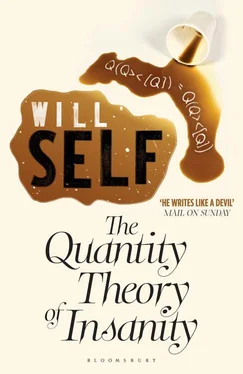I had always had a kind of a weakness for Sikorski. He was such an attractive man, and so enthusiastic, given to large passions. Very Slav. He was really the Bakunin of psychology, asexual and subject to borrowing large amounts of money that he couldn’t possibly hope to repay.
Now he stands. And then struts back and forth on the sward. Arms outstretched, he clutches up divots and presses them to his brow. His mouth opens and closes, but I can’t hear what he’s saying. Apparently he has been invited to Denver as a gift to the municipality from the conference organisers. The Radical Psychic Field Disruptionists are going to practise their strange arts in the vicinity of the state mental hospital and ameliorate the conditions of the inhabitants … that’s the idea at any rate.
Plenty of people, some of them quite respectable thinkers, believe implicitly in the efficacy of Radical Psychic Field Disruption. What a joke! These people haven’t a clue what Quantity Theory is really about. Quantity Theory is not concerned with total physical cause, it operates at the level of the signifier. People are willing to come forward in droves and claim that they have been helped by the actions of Sikorski and his followers. And it is considered slightly hip by the intelligentsia to piggyback on a field disrupting trip in order to obtain relief from some trying neurosis or other — to shuck off a co-dependant relationship, or ‘deal’ with some emotion or other. I have been told that nowadays it’s virtually impossible to pass a mental institution of any kind at all, without seeing a little ersatz ship of fools moored by the main door and in the shadows, lurking, a pasty-faced scion of the Sunday Review benefiting obscurely from the local field disruption.
As soon as my address is over and the ovation has been tidied away I stride out of the auditorium. Walking across the concourse I turn to Dagglebert, outraged.
‘What the hell are these people doing here? Why have the conference organisers allowed them into the precincts of the university?’
‘Oh, them,’ says Dagglebert — and as he speaks I see once again the utter stupidity of employing a research assistant who drools — ‘They’re here by invitation of the conference, as a gift to the municipality of Denver …’
‘I know that, I know that!’ I turn away from Dagglebert and head towards the cafeteria, which lies on the far side of the precinct. Dagglebert, undeterred, follows me, drooling the while.
Safely ensconced behind a chest-high arras of plastic bamboo shoots I watch the ebb and flow of conferees as the swarm coming from the auditorium runs into the traffic on the precinct and the Radical Psychic Field Disruptionists enter from the outside. Rocking and dribbling they stand here and there talking to former colleagues, half-remembered through a fog of tranquillisers.
I see my own former colleagues there as well. Zack Busner stands with a tall, shrouded girl, nervously rolling and unrolling the end of his mohair tie. Phillip Hurst has his briefcase propped open on one knee, foot up on the rim of a concrete shrubbery container as he riffles through notes for the benefit of a stocky individual, who flexes and reflexes his muscular arms. I see Adam Harley deep in conversation with Janner, the anthropologist, who I know vaguely. Janner is wearing what looks like a second-hand Burton overcoat and carries a plastic bag emblazoned with the logo of a popular chain of South London convenience stores. Janner is a repellent individual, with something of Alkan about him — the way he tilts his head back in order to slurp the catarrh down his throat is especially striking. I have no idea why he has chosen to be in Denver.
And here and there dotted around this space are other familiar figures. Faces from the past that split and reform with speech. A manic, Jewish type who looks like an accountant clutches a sheaf of marketing brochures under his arm, and stands engrossed, while Stein, that millenarian charlatan, lays down his new law. Sikorski is moving among the throng. There’s something hilarious about the way his false penis quests ahead of him. Especially if you know, as I do, that he’s completely impotent. He stops to shake hands and chat with well-wishers. However, he hasn’t knocked off work altogether. A slowly rotating strand of spittle still threads through his tangled, fair beard, twisting this way and that, catching and refracting the sunlight streaming through the skylights above.
And as I observe Sikorski and his cohorts the nervous irritation that has gripped me since I arrived in Denver starts to fade away. I am left with a sense that this conference, this scene, is a watershed for Quantity Theory. A heaven-sent second opportunity for me to re-establish the school of thought at the correct level with the correct emphasis. Where has Quantity Theory gone wrong? In its application? In its development as a therapy? As a method of social control? As a tool of radical psychiatric policy? In all and yet none of these areas. The truth, as ever, comes to me purely, in one flash of instant realisation. I knock over the styrofoam beaker full of tepid coffee that Dagglebert has placed at my elbow as I fumble through my pockets for pencil and notebook. I start to jot down a first attempt to express the realisation in some form of notation:
Q(Q> <[Q]) = Q(Q> <[Q])
Of course it would be possible to qualify this. It may be that this is itself too blindingly, elegantly simple and that the value ‘Q’ may have to be defined with some reference to a value external to itself. But for the moment it stands happily to explain what I see around me.
The Radical Psychic Field Disruptionists; the American students dressed in puffy, autumnal sports gear; the heads of a dozen university faculties gesturing with passion over a subject they neither know nor understand. And all of them, mark me, all of them, confined within definable societal groupings.
The Quantity Theory of Insanity has reached its first great epistemological watershed. Like theoretical physics it must now account for the very phenomenon it has helped to identify. It must reconstruct the proof of its own ground on the fact of its own enactment. Clearly, by concentrating so many aberrant and near-aberrant people in one place or series of places, the very fact of Quantity Theory has been impacting on the sanity quotient itself.
The task now is to derive an equation which would make it possible to establish whether what I suspect is true. Namely that as more and more insanity is concentrated around educational institutions, so levels of mental illness in the rest of society …
Select Bibliography
Ford, Hurst, Harley, Busner & Sikorski, ‘Some Aspects of Sanity Quotient Mechanisms in a Witless Shetland Commune’, British Journal of Ephemera , September, 1974.
Ford, H., ‘Teaching Stockbrokers Ring Dancing’, Practical Mental Health , January, 1975.
Ford, H., The Quantity Theory of Insanity , Publish Yourself Books, London 1976 (limited edition).
Ford, H., ‘Repressing People Who Laugh Alone: Towards Effective Public Transport’, The Bus , October, 1975.
Harley, T., ‘Shamanism and Soya Futures’, World Bank Research Briefs, September, 1979.
Hurst, P., ‘Nailbiting in Bournemouth versus Bed-Wetting in Poole: Action and Amelioration’, Journal of Psychology , March, 1976.
Hurst, P., ‘General Census of Sanity Quotients in the UK’, HMSO, January, 1980.
Sikorski, A., ‘ Daddy, Mummy’s Mad.’ ‘Good.’ , Shefcott and Willer, London 1976.
I used to play a game as a child. Well, not so much a game, it was more of a pastime. Lying in bed, if I squinted at the shafts of light that streamed in through the curtains they became solid. Solid tubes of brightness. I could extend and contract these tubes simply by the degree to which I squinted. It was a sensation of the most incredible kind of control, a control of a peripheral world that lay behind the thin sham of mere workaday appearances. A secret world. Lots of things happened to me during my childhood. It wasn’t happy or unhappy, it was eventful, but what I remember best are those solid tubes of brightness.
Читать дальше












